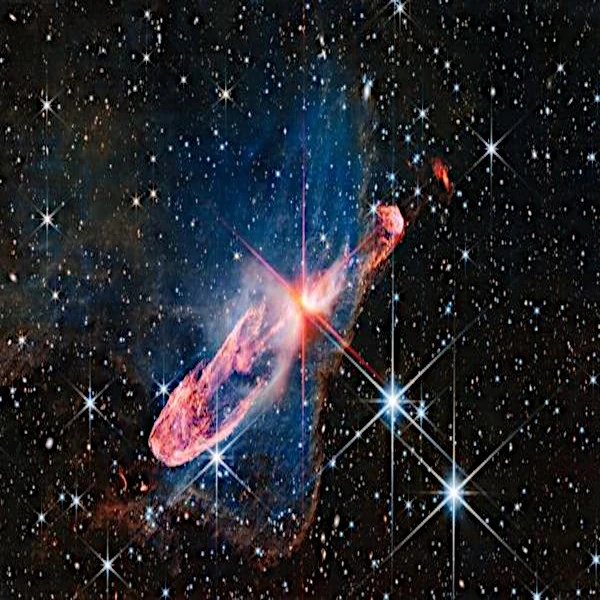
Image: In the orange-white spot in the center of this image are 2 actively forming stars. Both stars are buried deep in a disk of gas and dust that fuels their growth. JWST NASA's James Webb Space Telescope (Public domain).
A star is born from a nebula, an immense mass of interstellar gas and dust which are already the residue of ancient stars.
The main hypothesis for the first generation of stars is that they formed from a primordial gas composed mainly of hydrogen and helium, with no significant traces of heavier elements.
- The first stage in the life of a star is the gravitational collapse of the nebula, under the influence of external forces or disturbances.
External forces or disturbances may be shock waves from nearby supernovae or stellar flares. These disturbances can also come from gravitational interactions with other stars or from ionizing radiation coming from neighboring stars.
All these phenomena lead to the formation of a dense core and create areas of concentration of matter, favoring the formation of proto-stars. These processes, capable of compressing a nebula, ultimately trigger gravitational collapse.
- As the protostar collapses in on itself, the temperature and pressure increase rapidly. This increase is a function of the inverse square of the radius although the specific relationship depends on many other complex factors related to stellar physics.
The fusion temperature of hydrogen in the stellar core, associated with nuclear reactions, must reach 150 million degrees Celsius in order to overcome the Coulomb barrier. But thanks to the tunnel effect, the nuclear reactions of hydrogen fusion into helium will start before reaching this temperature. They will start around 15 million degrees.
The tunneling effect is a well-known quantum phenomenon in quantum mechanics. It occurs when particles penetrate through a classically impenetrable energy barrier.
This is the beginning of the main sequence phase, where the star generates a massive amount of energy through nuclear fusion.
- Over time, the star depletes its hydrogen, leading to changes in its internal structure.
For medium-sized stars like the Sun, this marks the beginning of the expansion into a red giant.
As the core contracts, the temperature rises enough that the helium begins to fuse into heavier elements. This occurs in a shell around the nucleus.
As helium fuses in the shell, the energy released creates significant pressure that causes the outer layers of the star to swell. The star's outer envelope expands, and it becomes colder, giving the star a reddish appearance.
This expansion is mainly due to the increase in the star's luminosity and the pressure generated by the fusion of helium in the shell. During this phase, the star may also lose a significant portion of its mass in the form of stellar winds. These stellar winds eject outer layers of the star into interstellar space.
- The sequence of fusion reactions depends on the mass of the star.
For more massive stars, fusion continues with heavier elements. This phase sees the fusion of hydrogen (H) into helium (He) in the core of the star. Then helium (He) into carbon (C) and oxygen (O), then carbon (C) and oxygen (O) into neon (Ne) and magnesium (Mg). Even more massive stars continue to fuse heavier elements, producing silicon (Si) and sulfur (S). Finally, the fusion of silicon (Si) produces iron (fe). This is a crucial step because the fusion of iron does not release energy but absorbs it. Which means that when a star's core reaches a significant concentration of iron, fusion ceases and the star can no longer maintain the pressure necessary to counterbalance the gravitational force.
- For even more massive stars, the accumulation of iron in the core triggers a sudden gravitational collapse. This sudden collapse triggers a supernova, that is to say a cataclysmic explosion which releases a phenomenal quantity of energy. It is this colossal quantity of energy which will allow the formation of heavier elements by neutron capture.
The capture of neutrons will lead to the creation of elements heavier than iron. Atom nuclei can capture additional neutrons, forming unstable isotopes that will then decay into heavier elements. Elements such as uranium, platinum, gold, and many others can be formed this way.
Sometimes neutron stars or black holes appear, depending on the residual mass of the original star.
All the residues of old stars thus generated will seed interstellar space.
Other gas and dust nebulae may collapse, under the influence of external forces or disturbances, thus continuing the cycle of star formation.
Ultimately, a star's fate depends on its mass, with each stage governed by complex physical processes related to gravity, pressure, temperature and nuclear fusion.